Jebel Shams Star Party, 7th October 1999
The Ras al Hamra
Astronomy Section had a star party at Jebel Shams on the night of 7th to 8th
October. This was after several days of clear weather, the first week that the
mugginess and heat haze of our summer had gone. Since the altitude at the camp
site was somewhere between 2500 and 3000 meters, the transparency of the air was
truly amazing. The Milky Way was so obvious you didn't have to look for it. It
was right there, staring you in the face, a fabulous arc overhead. Please be
patient if you have a slow connection, downloading a lot of photos. Probably
better this way than the even slower method of going via thumbnails... Here is a
photo at 1715 when we arrived, everyone setting up camp:
For other stuff visit
Samir's Home To drop me an e-mail just
click on: 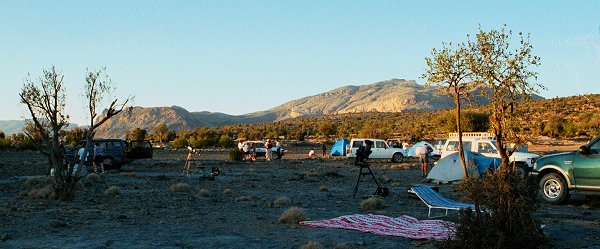
Camping was rather popular that weekend, not just for star gazing. There
must have been more than 30 or 40 cars spread over various nearby sites. I am
afraid we Omanis are a bit sensitive to the cold. The temperature dropped a bit
after sunset. Oh, must have gone all the way down to 15 degrees Centigrade, but
the way some of my compatriots were dressed ...! Ski parkas with hoods up, head
scarves... Actually a most pleasant temperature for star gazing. Below is a
photo of the Southern horizon. Sorry, the camera was tilted, not the land. I had
not yet figured out how to mount the camera at any angle I wanted on the scope.
My Celestron Ultima 2000 - 8" was on an equatorial wedge (for tracking) and the
camera piggy-backed on it. Lens used for all photos on this page (except the one
indicated otherwise) was my latest toy, a Tamron 14mm super wide angle lens.
Beautiful glass beast! Heavy, thus the problems with balancing. And no, it's not
a fish-eye. I am absolutely amazed at the quality of modern day lenses, a
rectilinear one at 14mm covering a full 35mm frame! Wide open at f2.8 it gives
tack sharp star images right to the edges of the 35mm frame, certainly sharp
enough for the Fuji ISO 800 colour negative film I was using. Even though this
lens @ $1300 is a lot cheaper than the Canon one, I certainly do not see how
much improvement Canon can possibly make on it to justify their much higher
price. I would highly recommend the Tamron to anyone. Those lights at the bottom
right corner show Randall Penney's shenanigans with his red flashlight, setting
up the Club telescopes. For orientation, note the Summer Triangle of bright
stars, Altair, Deneb and Vega. 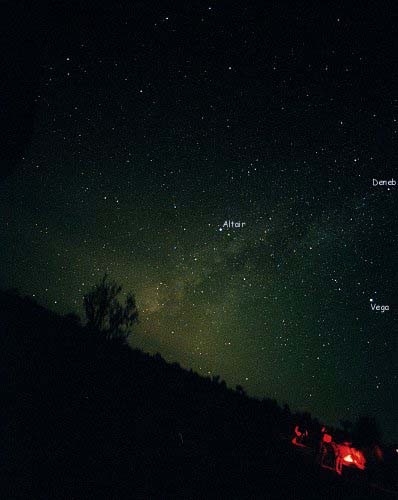
Look at the mind-blowing
photo of the Milky Way below. Normally a 4-minute exposure at f2.8 at Ras al
Hamra yields a washed out sky on Fujicolor 800. The photo below was for 6
minutes. I took photos at 2, 4 and 6 mins (at f2.8), thinking that the 6 mins
would be a total wash-out. But the sky was so dark and clear, even though with
our eyes adjusting, looking so brilliant, I really should have gone for 8 and 16
mins. Something to note for next time. 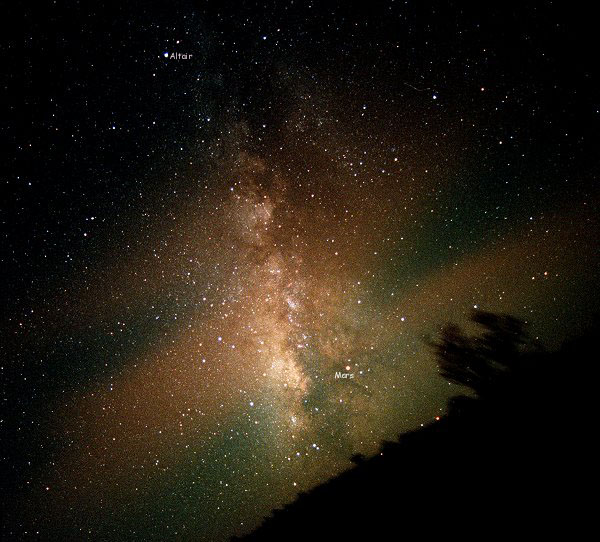
Anyway, below is a
cropped version, enlarged, with the horizon horizontal:
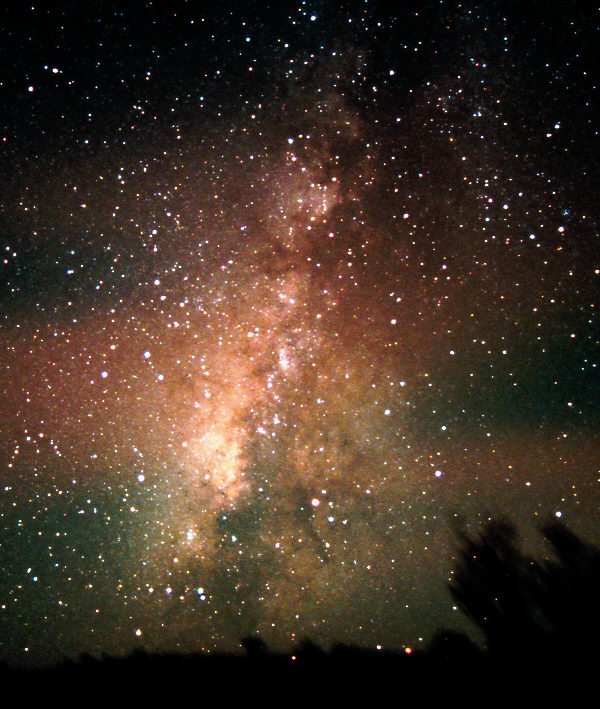
So
what on Earth are those coloured horizontal bands? They are not camera
artifacts. They also show up on other photos, so the only thing I can think of
is some very thin clouds that were not visible by eye. An effect similar to a
colourful sunset? Away from the horizon, more or less straight overhead, the
colour bands are not visible, see image below, even though also with a 6 mins
exposure. You can easily see the dark lanes in the Milky Way in both photos.
And, oh, by then I had figured out how to mount and point the camera, with a
heavy lens, to any direction. Secret is to rest the fork-mounted scope on its
altitude "downstop" so no delicate balancing is required. A ball-and-socket head
then provides total freedom for the camera. 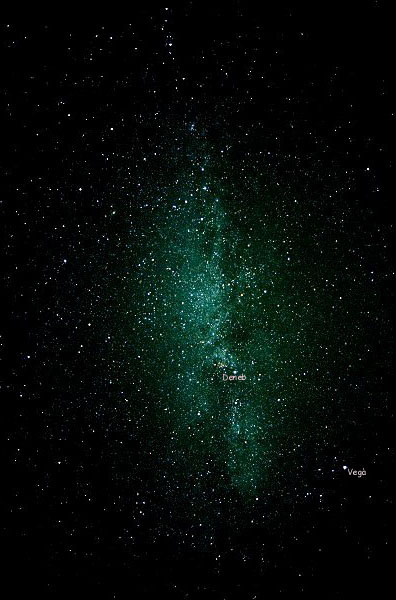
Sticking a
100mm lens and looking at the dense star field in the middle of the above photo
yields the image below. Wow! That's a lot of stars. Actually it was windy enough
that I expected rather shaky images and did not bother to take more photos. We
spent a few hours looking at all kinds of stuff; Ring Nebula, Wild Duck Cluster,
M13, etc, etc. The sky was so transparent you could even see M31, the great
galaxy in Andromeda, with the naked eye (just about), but with binoculars you
could clearly make out the elliptical shape and also its companion galaxy. It's
often said that M31 is the furthest object that can be seen with the naked eye,
and at 2.3 million light years, that's quite far! The Ring Nebula was so clear
in the Club's 11" that one could easily get infected with aperture fever...
Randall was waxing lyrical about the gossamer look of the Dumbell Nebula. We
also had a look at several more distant galaxies, but these, to me, are so faint
that I can't say I get too excited except as photo challenges. Fortuitously we
also got to see a transit of one of Jupiter's moons over its surface. But again,
far too windy for photography. Pity. 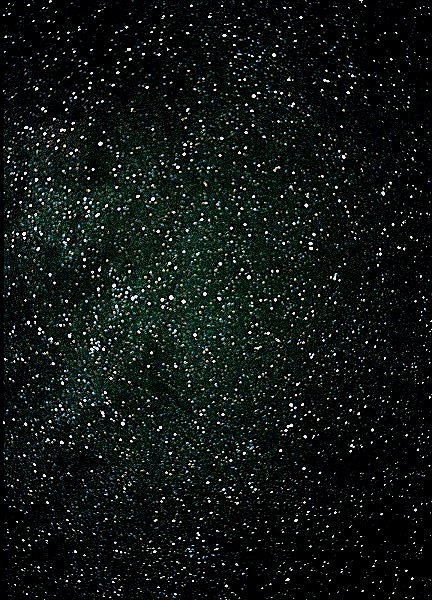
The morning after, with
the camp waking up at around 0600. 
A quick ride to the
"Grand Canyon" next door and a bit of early morning photography. This place
never ceases to amaze me. Somebody ought to measure how deep it is one of these
days. 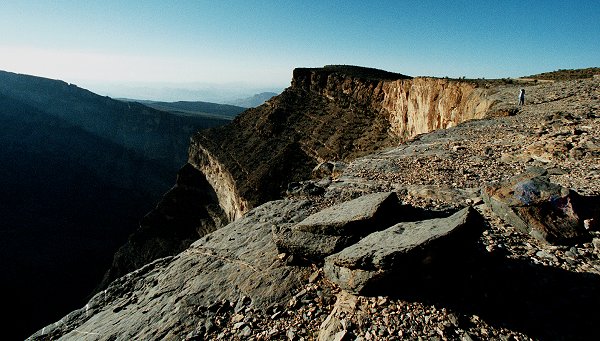
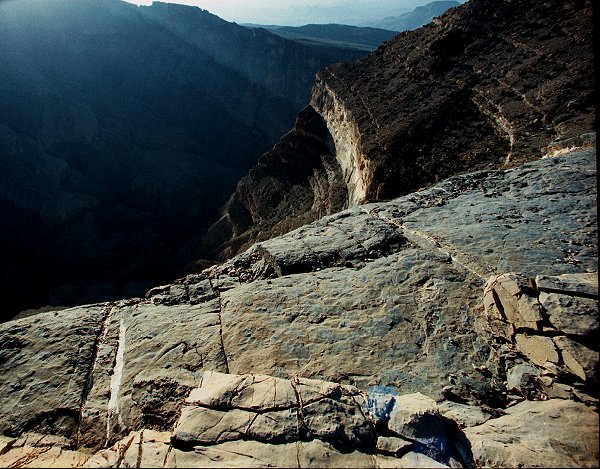
Look at that deep blue
sky on the long ride back to Muscat: 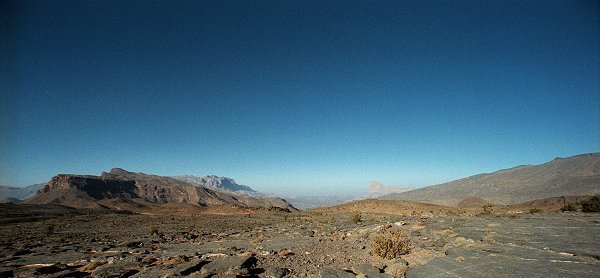
This was my first trip to
a star party (too lazy) and my comment to all you fellow-lazies out there is,
you sure missed a sparkling sky!
samirkharusi